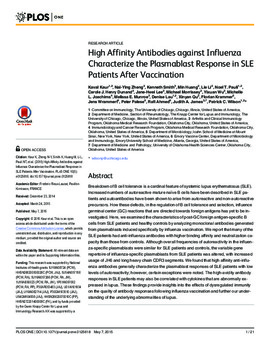| dc.contributor.author | Kaval Kaur | |
| dc.contributor.author | Nai-Ying Zheng | |
| dc.contributor.author | Kenneth Smith | |
| dc.contributor.author | Min Huang | |
| dc.contributor.author | Lie Li | |
| dc.contributor.author | Noel T. Pauli | |
| dc.contributor.author | Carole J. Henry Dunand | |
| dc.contributor.author | Jane-Hwei Lee | |
| dc.contributor.author | Michael Morrissey | |
| dc.contributor.author | Yixuan Wu | |
| dc.contributor.author | Michelle L. Joachims | |
| dc.contributor.author | Melissa E. Munroe | |
| dc.contributor.author | Denise Lau | |
| dc.contributor.author | Xinyan Qu | |
| dc.contributor.author | Florian Krammer | |
| dc.contributor.author | Jens Wrammert | |
| dc.contributor.author | Peter Palese | |
| dc.contributor.author | Rafi Ahmed | |
| dc.contributor.author | Judith A. James | |
| dc.contributor.author | Patrick C. Wilson | |
| dc.date.accessioned | 2017-03-05T22:54:54Z | |
| dc.date.available | 2017-03-05T22:54:54Z | |
| dc.date.issued | 2015-05-07 | |
| dc.identifier.citation | Kaur K, Zheng N-Y, Smith K, Huang M, Li L, Pauli NT, et al. (2015) High Affinity Antibodies against Influenza Characterize the Plasmablast Response in SLE Patients After Vaccination. PLoS ONE 10(5): e0125618. doi:10.1371/journal.pone.0125618 | en_US |
| dc.identifier.uri | https://hdl.handle.net/11244/49260 | |
| dc.description | We thank Elena Solomaha for advice on SPR experiments, Angela Hayes for clerical support, Christina Helms and Lori Garman for technical assistance, Gillian M. Air for providing influenza viruses; Linda F. Thompson for early involvement in the study and Meghan Sullivan, Irvin Ho and Sarah F. Andrews for helpful comments on the manuscript. | en_US |
| dc.description | | en_US |
| dc.description.abstract | Breakdown of B cell tolerance is a cardinal feature of systemic lupus erythematosus (SLE). Increased numbers of autoreactive mature naïve B cells have been described in SLE patients and autoantibodies have been shown to arise from autoreactive and non-autoreactive precursors. How these defects, in the regulation of B cell tolerance and selection, influence germinal center (GC) reactions that are directed towards foreign antigens has yet to be investigated. Here, we examined the characteristics of post-GC foreign antigen-specific B cells from SLE patients and healthy controls by analyzing monoclonal antibodies generated from plasmablasts induced specifically by influenza vaccination. We report that many of the SLE patients had anti-influenza antibodies with higher binding affinity and neutralization capacity than those from controls. Although overall frequencies of autoreactivity in the influenza-specific plasmablasts were similar for SLE patients and controls, the variable gene repertoire of influenza-specific plasmablasts from SLE patients was altered, with increased usage of JH6 and long heavy chain CDR3 segments. We found that high affinity anti-influenza antibodies generally characterize the plasmablast responses of SLE patients with low levels of autoreactivity; however, certain exceptions were noted. The high-avidity antibody responses in SLE patients may also be correlated with cytokines that are abnormally expressed in lupus. These findings provide insights into the effects of dysregulated immunity on the quality of antibody responses following influenza vaccination and further our understanding of the underlying abnormalities of lupus. | en_US |
| dc.language.iso | en_US | en_US |
| dc.publisher | PLos One | |
| dc.relation.ispartofseries | PLoS ONE 10(5): e0125618 | |
| dc.relation.uri | http://www.plosone.org/article/info%3Adoi%2F10.1371%2Fjournal.pone.0125618 | |
| dc.rights | Attribution 3.0 United States | |
| dc.rights.uri | https://creativecommons.org/licenses/by/3.0/us/ | |
| dc.subject | Antibodies,Enzyme-linked immunoassays,Systemic lupus erythematosus,B cells,Influenza,Antibody response,Immune response,Cytokines | en_US |
| dc.title | High Affinity Antibodies against Influenza Characterize the Plasmablast Response in SLE Patients After Vaccination | en_US |
| dc.type | Research Article | en_US |
| dc.description.peerreview | Yes | en_US |
| dc.description.peerreviewnotes | http://www.plosone.org/static/editorial#peer | en_US |
| dc.identifier.doi | 10.1371/journal.pone.0125618 | en_US |
| dc.rights.requestable | false | en_US |

